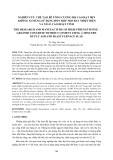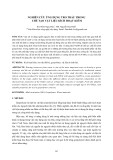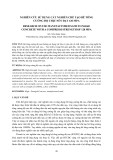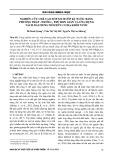
Journal of Science and Transport Technology Vol. 2 No. 2, 31-38
Journal of Science and Transport Technology
Journal homepage: https://jstt.vn/index.php/en
JSTT 2022, 2 (2), 31-38
Published online 26/06/2022
Article info
Type of article:
Original research paper
DOI:
https://doi.org/10.58845/jstt.utt.2
022.en.2.2.31-38
*Corresponding author:
E-mail address:
quantv@utt.edu.vn
Received: 19/05/2022
Revised: 04/06/2022
Accepted: 20/06/2022
Investigation in manufacturing self-healing
cementitious materials using microbial
technology
Van Quan Tran*, Van Loi Giap
University of Transport Technology, 54 Trieu Khuc, Ha Noi, Viet Nam
Abstract: Small cracks are inherent in cementitious-based structures. This
causes deterioration of buildings, reducing the bearing capacity of structures
due to the invasion of harmful substances as well as corrosion of reinforcement
in cementitious material. Therefore, the cementitious material needs to be
restored and these voids filled. Self-healing cementitious material has been
strongly developed for long time in the world. However, this technology has not
been popular in Vietnam. Therefore, the aim of this paper is to find the
appropriate mix-design for creating self-healing cementitious material in
Vietnam conditions. Experimental results show that the mixture including
bacillus subtilis and calcium lactate can be used for creating the self-healing
cementitious materials. Mixing directly the mixture in the cement is selected to
manufacture the self-healing cementitious materials. It seems that the width of
crack affects more on healing ability than the length of crack.
Keywords: Self-healing mortar, cementitious material crack healing, Bacillus
subtilis, calcite mineral, calcium lactate.
1. Introduction
Reinforced cementitious materials is a type
of composite material combined by cementitious
materials and steel, in which cementitious material
and steel participate in bearing forces. In Vietnam,
there are many reinforced cementitious materials
works built with structural problems such as cracks
appearing during construction and use. There are
many causes leading to the cracking of reinforced
cementitious material such as: cracking due to
structural deformation, plastic stability, shrinkage,
reinforcement corrosion, reinforcement expansion,
etc. Cracks affecting the safety of the structure
need to be treated or reinforced to ensure safety
for construction works.
There are many methods to strengthen
cracked structures in reinforced cementitious
material, but they are expensive and time
consuming. One of those measures is the method
of using microorganisms to cure cementitious
material. Cementitious material is a highly alkaline
material with (pH>12) so the microorganisms used
need to be tolerant of this environment [1].
Microorganisms create calcium carbonate
precipitates that bind other materials such as
gravel and sand in cementitious material thereby
helping to fill cracks [2]. The participation of
microorganisms in the calcium precipitation
process increases the strength and durability of
cementitious material [3].
The main mechanism for precipitation of
CaCO3 is the breakdown of urea by microbial urea

JSTT 2022, 2 (2), 13-38
Tran & et al
32
enzymes. Microorganisms produce urea fertilizer,
which catalyzes urea to carbonate and ammonium
which increases the pH and carbonate
concentration in the environment surrounding the
bacteria. These substances are hydrolysed to
ammonia NH4
+ and carbonic acid CO3
2- leading to
the formation of calcium carbonate when combined
with a medium rich in Ca2+ ions of calcium
carbonate in cementitious material. The process of
hydrolysis of urea CO(NH2)2 to carbonic acid CO3
2-
and ammonium NH4
+ is as follows [4]
𝐶𝑂(𝑁𝐻2)2+ 𝐻2𝑂 →
𝑒𝑛𝑧𝑦𝑚
𝑁𝐻2𝐶𝑂𝑂𝐻 + 𝑁𝐻3
(1)
𝑁𝐻2𝐶𝑂𝑂𝐻 + 𝐻2𝑂 → 𝑁𝐻3+ 𝐻2𝐶𝑂3
(2)
𝐻2𝐶𝑂3↔𝐻𝐶𝑂3
−+ 𝐻+
(3)
2𝑁𝐻3+ 2 𝐻2𝑂 ↔ 2𝑁𝐻4++ 2𝑂𝐻−
(4)
𝐻𝐶𝑂3
−+ 𝐻++ 2𝑁𝐻4
++ 2𝑂𝐻−
↔ 𝐶𝑂3
2− + 2𝑁𝐻4
++ 2 𝐻2𝑂
(5)
The cell wall of microorganisms (cell)
−𝐶𝑒𝑙𝑙 + 𝐶𝑎2+ ↔ 𝐶𝑒𝑙𝑙 − 𝐶𝑎2+ is negatively
charged, so bacteria absorb Ca2+ cations from the
cementitious material environment to form Ca2+ ion
membranes. The Ca2+ ions react with the
carbonate anion CO3
2- to precipitate calcium
carbonate at the cell surface of the microorganisms
[1] (Figure 2). This process can be described
through chemical equations (6) and (7)
−𝐶𝑒𝑙𝑙 + 𝐶𝑎2+ → 𝐶𝑒𝑙𝑙 − 𝐶𝑎2+
−𝐶𝑒𝑙𝑙 + 𝐶𝑎2+ → 𝐶𝑒𝑙𝑙 − 𝐶𝑎2+
(6)
𝐶𝑒𝑙𝑙 − 𝐶𝑎2+ + 𝐶𝑂3
2− → 𝐶𝑒𝑙𝑙 − 𝐶𝑎𝐶𝑂3
(7)
Fig 1. Diagram of calcium carbonate precipitation
produced by microorganisms [3]
Fig 2. Carbonization of microbial cell walls [1]
A series of studies on self-healing
cementitious material in general and self-healing
cementitious material using microorganisms in
particular have been scrutinized worldwide. For
example, the study of Tanvir Qureshi and Abir Al-
Tabbaa [5] has shown in quite detail the impact of
microorganisms on the self-healing process of
cement materials. In particular, mainly focus on
self-healing cementitious material in traditional
ways such as using fibers, polymers, minerals and
additional additives, as well as some new non-
traditional ways such as using capsules. with
polymeric agents, minerals and microorganisms.
Many other studies have also focused more on the
use of microorganisms for self-healing
cementitious material materials. That is the study
of Kunamineni Vijay et al. [6], H.M. Jonkers & E.
Schlangen [7], these studies have elaborated on
the microbial self-healing process with hydration
and calcite precipitation reaction to fill cracks in the
structure. cementitious material. Accordingly, the
study of Mohamed Alazhari et al. [8] also clarified
the suitability of the microbial capsule system and
determined their necessary ratios necessary to
ensure the self-conforming process. More fully
assessed, research by J.Y. Wang et al. [9]. By
focusing on research, examining the self-healing
process of cementitious material materials when
using micro-capsules containing microorganisms,
the author has demonstrated the effectiveness of
the method of using microorganisms to bring the
self-healing efficiency for cementitious material
samples is much higher than that of other methods.
With the method of using microorganisms for
self-healing cementitious material materials, the

JSTT 2022, 2 (2), 13-38
Tran & et al
33
problem is that the specific bacteria selected must
be able to withstand the high alkalinity of the
cement and the compressive pressure inside the
structure. Along with that, it is also necessary to
have a source of nutrients available to provide for
the activity of microorganisms. A series of tests
have been carried out towards the application of
self-healing cementitious material into practical
use. Experiments by [1] Wiktor and Jonkers (2011)
have shown that cracks up to 0.46 mm can be
completely filled with self-healing cementitious
material using microorganisms, however effective
of this method can be limited if bacterial spores
lose their ability to survive in overly dry
environments. In addition, Wiktor and Jonkers [10]
also conducted experiments with Bacillus
pseudofirmus and Bacillus cohnii spores that
demonstrated self-healing ability based on visual
observation of results from calcium carbonate
precipitation reactions on Cracked surfaces after
100 days of immersion in water. Huang and Ye
(2011) [10] added 5mm capsules containing
sodium silicate to the cement mix, the cementitious
material structure then showed a recovery of
mechanical properties including flexural strength
and strength after being damaged by the three-
point bending test. Thereby, microbial self-healing
cementitious material has demonstrated that their
recovery is accompanied by recovery in both
mechanical and transmission properties, however,
it may not be achieved. 100% efficiency as well as
the need to minimize the repetition of failures and
recovery processes [11], [12], [13]. Currently, the
two main methods used to introduce
microorganisms into cementitious material are
direct mixing of microorganisms and packaging of
microorganisms into pellets and mixing into
cementitious material. These two methods have
their own advantages and disadvantages, the
direct mixing method has the advantage of being
simple, non-polluting, but it is necessary to have
measures to ensure the survival of bacteria. In
contrast, mixing pellets requires high requirements
in terms of packaging technology as well as
complexity in the mixing process to ensure no
breakage as well as evenly distribute the pellets in
the cementitious material [14]. However, the
method of mixing tablets in the form of tablets
ensures the survival of bacteria, so it can be
applied to many types of components under the
effect of many types of loads. There are many
types of bacteria studied and applied in the world
such as Bacillus sp. CT-5, Bacillus megaterium,
Bacillus subtilis, Bacillus aerius, Sporosarcina
pasteurii, AKKR5 and Shewanella Species.
A series of studies in Vietnam have analyzed
and evaluated to bring self-healing concrete into
application for construction projects across the
country. An article on the Center for Information
and Statistics of Science and Technology of Ho Chi
Minh City [15] mentioned an overview of self-
healing concrete materials as well as the current
status of research and application of this material
on world. Going a little deeper, a research essay
has been done by students of Ho Chi Minh City
University of Technology [16] on the topic
"Application of biology in construction day" has
initially entered the work. The study of self-healing
concrete under the influence of microorganisms
and an overview of the development direction of
this material in Vietnam. In addition, the study by
Le Quynh Loan and his colleagues published in the
Scientific Journal of Ho Chi Minh City University of
Education [17] clarified and described the calcite
precipitation reaction with the influence of bacteria
from cementitious samples. In more detail, Nguyen
Ngoc Tri Huynh and Nguyen Khanh Son, from Ho
Chi Minh City University of Technology, have
conducted quite complete studies and
assessments on self-healing concrete applying the
bioactive mechanism of concrete bacteria Bacillus
subtilis [18]. This study demonstrated the effect of
bacteria in the self-healing process, as well as the
improvement of the mechanical and mechanical
properties of this self-healing concrete material.
Overall, the domestic investigations have not
clarified the mixing method and mixing materials
into concrete to make self-healing concrete.
Through detailed research overview, this study
proposes to use direct mixing technology with the

JSTT 2022, 2 (2), 13-38
Tran & et al
34
advantages of easy implementation. In addition,
the main aim of this study is to propose mixing
materials including type of bacterial and type of
nutrient to successfully manufacture self-healing
concrete in Vietnamese conditions with domestic
material.
2. Experimental methodology
2.1. Selection of materials, microorganisms
and fabrication nutrients
The aim of this paper is to initially evaluate
the success of self-healing cementitious materials
in Vietnam condition with domestic materials.
Therefore, the cement mortar mixture was used.
The mix design of mortar includes sand 581 kg/m3,
cement 450 kg/m3 and water 180 kg/m3. The
cement used in the research is Xuan Thanh PCB
40 cement. This is a mixed Portland cement that
meets the requirements of technical standards
according to TCVN 6260:2009. Sand meets the
Standard requirements TCVN 7570:2006.
Table 1. Grain composition of sand
Size of sieve
hole
Amount of residue
accumulated on sieve (%
mass)
2,5 mm
From 0 to 20
1,25 mm
From 15 to 45
630 mm
From 35 to 70
315 mm
From 65 to 90
140 mm
From 90 to 100
Amount through
sieve 140 mm,
not more than
10
The selected microorganisms are in
accordance with the standard conditions of
Vietnam. In this study, the author used the most
widely used and popular family of bacillus
microorganisms to make self-healing cementitious
material by microorganisms [19]. Through the
study, the source of bacillus subtilis in water can be
divided into 3 types as illustrated in Figure 3 [20].
Bacillus subtilis microbial products in water
exist in 3 main forms: (i) pure form in seed tubes
(Figure 3a), (ii) powdered preparations for food
technology and medicine (Figure 3b), (iii) powder
form for agricultural use as animal feed or as a
decomposing agent in aquaculture ponds (Figure
3c). In this study, the authors used 2 preparations
shown in Figure 3b and Figure 3c for
experimentation because these are two products
with low cost and relatively large number of spores
(a)
(b)
(c)
Fig 3. Sources of bacillus subtilis in water
2.2. Nutrient source for microorganisms in
cementitious material.
Microorganisms in order to survive and grow
and create calcite minerals in Cementitious
material need a suitable nutrient environment.
There are 2 nutrient mediums: urea-containing
(type 1) and urea-free (type 2). For type 1 nurturing
environments, several studies from around the
world are summarized in the following tables
Microorganisms in order to survive and grow
and create calcite minerals in Cementitious
material need a suitable nutrient environment.
There are 2 nutrient mediums: urea-containing
(type 1) and urea-free (type 2). For type 1 nurturing
environments, several studies from around the
world are summarized in the following tables [21],
[22], [23], [24]:
Table 2. Composition of nutrient medium type 1
for bacillus subtilis
Component
Quantification (g)
Microbiology Bacillus
subtilis
-
Urea
7.0
Nutrient Broth (Nutrition
soup)
2.1
(NH4)2CO3
7.0
CaCl2.2H2O
5.0

JSTT 2022, 2 (2), 13-38
Tran & et al
35
Table 3. Composition of nutrient medium type 2
for bacillus subtilis
Component
Quantification
(g)
Rate (%)
Microbiology
Bacillus subtilis
2.25
22.61
Urea
2
20.10
Nutrient Broth
0.5
5.03
NH4Cl
0.2
2.01
CaCl2.2H2O
1
10.05
NaHCO3
4
40.20
For type 2 nutrient medium, several mixtures
are used: nutrient broth (beef broth + peptone +
NaCl) [25], Mueller Hinton (MH) or Trypton Soy
Broth broth. [26], yeast extract medium [27], or
type 3 contains only calcium lactate C6H10CaO6
[20], [28]. Among these materials, calcium lactate
C6H10CaO6 has the cheapest price and is easy to
find in Vietnam market.
2.3. Mixing self-healing mix design
The nutrient medium type 1, the research
group used to create the precipitation of CaCO3
The substances used to create the type 1 nutrient
mixture (Figure 4). The composition is used as
shown in (Table 3) with 2 types of bacillus subtilis
Fig 4. Substances used in the preparation of
mixtures of nutrient media type 1
Proceed to mix the above substances and
two types of bacillus subtilis preparations (Figure
5). The two types of microbial preparations bacillus
subtilis correspond to two densities of 2.05×1010
cfu/g and 2.57×109 cfu/g, respectively. These
densities were diluted in 1000 ml of water also with
a mix of one nutrient medium.
Fig 5. Experiment on mixing and precipitation of
calcium carbonate of two microbial preparations
bacillus subtilis in a mixture of nutrient medium
type 1
Experimental results of mixed solution with
initial bacillus subtilis bile 2.05×1010 cfu/g did not
appear calcium carbonate precipitate while
solution with initial density of bacillus subtilis
2.57×109cfu/g appeared precipitate of calcium
white carbonate suspension transparently on the
surface of the solution as well as inside the
solution. It can be seen that even under normal
conditions, bacillus subtilis can also produce
CaCO3 precipitates. Nutrient group type 3 is
calcium lactate C6H10CaO6 mixed with two types of
bacillus subtilis concentration directly into the
cementitious material mixture to cure cementitious
material. This study proposes to use direct mixing
in mortar mixture with the advantages of easy
implementation.
2.3. Testing of the healing ability of
cementitious material
The evaluation of the success of the mixture
of bacillus subtilis and calcium lactate C6H10CaO6
in the manufacture of self-healing cementitious
material will be initially investigated with a mortar
mixture of sand 581 kg/m3, cement 450 kg/m3 and
water 180 kg/m3. The ratio of
microbiological/nutritional mixing is 1:1, with the











![Bài giảng Quản lý vận hành và bảo trì công trình xây dựng [chuẩn nhất]](https://cdn.tailieu.vn/images/document/thumbnail/2025/20251006/agonars97/135x160/30881759736164.jpg)









![Ngân hàng câu hỏi trắc nghiệm Sức bền vật liệu 1: [Mô tả/Định tính Thêm để Tăng CTR]](https://cdn.tailieu.vn/images/document/thumbnail/2025/20250920/kimphuong1001/135x160/6851758357416.jpg)


![Trắc nghiệm Kinh tế xây dựng [chuẩn nhất]](https://cdn.tailieu.vn/images/document/thumbnail/2025/20250920/kimphuong1001/135x160/32781758338877.jpg)

